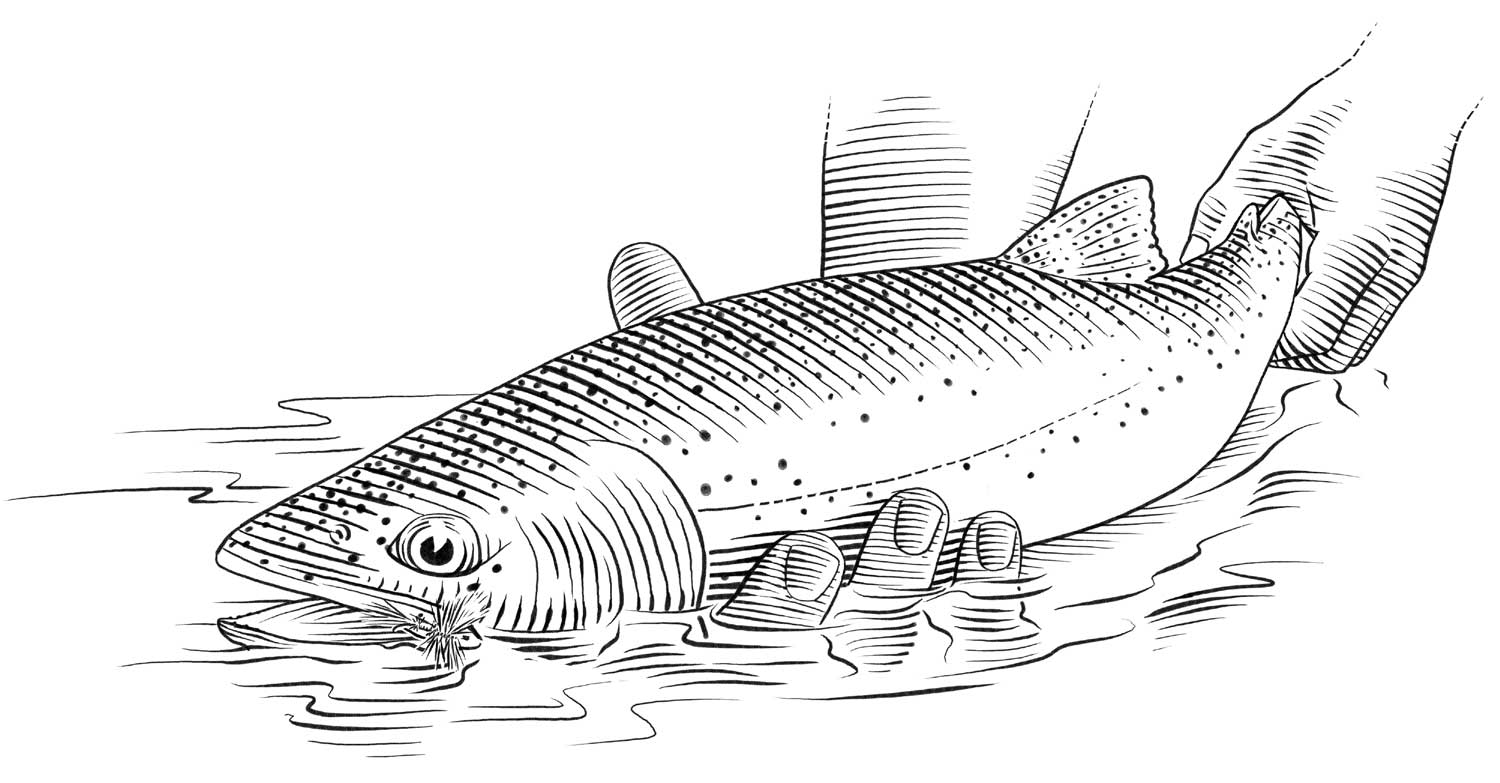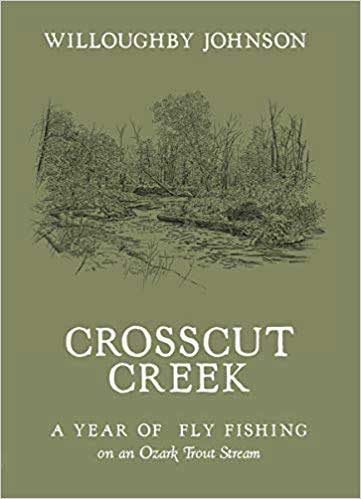“Crosscut Creek: A Year of Fly Fishing on an Ozark Trout Stream”
April

illustration by Keith Witmer
The following Saturday evening I fish Wayne Hardy’s. The sun’s begun to set, covering the land in diffuse, golden light. A cool breeze blows away the lingering heat of another sultry April afternoon. The pasture rolls down to the creek from Wayne’s house, scrubbed Holsteins grazing knee deep in lush spring grass. Creekside, the trees have barely started to leaf out, so that the overall impression of them is not of their foliage but of their stolid trunkness, great random columns scattered in the green pasture along the shining creek.
Riffles run down to the bridge (a relatively recent innovation: Grisham’s Ford was really a ford until only about twenty years ago) and above the riffles is a deep hole with a rope swing over it and a gravel bar on one side. In the summer the Hardys have evening bonfires here, and once or twice a year Janet’s church meets here for baptisms.
The wind picks up as evening approaches and I’m casting right into it, trying to get the fly to land and float along the crease where the creek flows against the deep pool beyond. Trying is the key word there because I’m not really having much luck. Part of it is the cobwebs of not having been out for a week, part of it is the wind, and part of it is the perfect the end of the day, which makes my mind wander to thoughts of supper.
A couple of fish do rise in the pool beyond the current and I cast to them, but they’ve got to be eating some tiny midges—something nearly invisible—and my very small but by no means tiny little brown caddis pattern doesn’t attract them. In a moment of inattention my cast goes astray and the line wraps itself around the rope swing, a nasty tangle that means I have to wade out into the hole, ruining it for fishing and burning precious, gorgeous minutes of this fleeting afternoon in unraveling an ungodly knot of frayed rope, line, leader, tippet, and fly. Of course as I’m doing this some fishermen from the Game Department land saunter on to the bridge and are kind enough to stop and watch me. At least they don’t catcall, and I think I know why: they’ve been there.
On my knees in the shallows I fish the next riffle, again and again flicking the fly out and letting it float down the five-inch-deep rapids. I float the fly along the far shore, in the middle, close-in. Fifty, sixty, eighty times? Finally, a trout strikes. I lift the rod to set the hook and momentarily feel its weight against my hand. Then nothing. The line springs into the air and lands behind me on the gravel bar, the tippet bare of the fly. A bad knot. The hook broke off and a half hour of patient angling is wasted. I lay the rod on the gravel bar and, resisting the temptation to stomp on it (as if it was the rod’s fault), walk away from the creek, up into the pasture. A nearby Holstein glances back at me, turns away, and shits in my direction.
Upstream fifty yards or so a long riffle ends in a deep slow run. Where fast water meets slow there’s a flume on the surface, the kind of place a hungry fish will hang out late in the day. I’ve had my fill of caddis flies this day: I carefully tie on my old standby, a Royal Wulff, pulling the hook against the tippet to test that the knot is tight and strong. And after a couple of sloppy casts and one time wrapping the line around a dead branch on the back cast, rhythm returns again and I begin casting to the deep water along the far shore, working my way up to that perfect water at the top of the hole.
On the third or fourth cast a fish strikes, and I lift the rod and feel weight against the hook, and then the fish jumps in front of me, glistening in the late afternoon light. Back in the water it makes a dash downstream on the far side of the creek, and then, reaching the end of the line, jumps again. I strip line in and reel the slack tight, then the fish pulls again, pulling line from the reel, heading downstream. Afraid I’ll lose it in a snag or under the bank I reel against the fish, bringing it back into the slow, deep water in front of me. When it jumps right in front of me every scale and every line in each fin is perfectly wrought in the afternoon light against the glowing green pasture beyond. Back in the water the trout zigzags in front of me. After wetting my hands and a few failed attempts I take the trout in hand and lay it in a bed of clover on the chest-high shore.
It’s lovely, longer than my forearm, sleek and lean, silver with black spots on its back, a pale streak of pink running on his side, thousands of tiny, perfectly arranged scales, orange tips on its pectoral fins. It’s nearly impossible to conceive that this remarkable creature lying in front of me began its life in this creek just four or five years ago as an egg no bigger than one of the black spots on its side.
There’s no doubt this trout would just as soon have remained uncaught, but in addition to inflicting this indignity on it, I’ve failed this fish in that the forceps which I use both to press down the barbs on hooks and to remove hooks went missing a week ago and I forgot to buy new ones at the fly shop two days ago. If my ethics were pure I wouldn’t have gone fishing at all today, since my hooks have barbs on them and I don’t have the means to remove a barbed fly from a fish’s mouth. It’s rank selfishness and sloppiness on my part, and this gorgeous trout is the unfortunate victim.
Though the fly isn’t down deep in the trout’s mouth, it’s set deeply in the left side. I try to pull it out but I’m afraid of doing more harm than good. To my mind the best and quickest way to get the fish back in the water with the least damage is to cut the fly off and leave it. I do this, wet my hands again, gently take hold of the fish, and hold him in the water, walking upstream to get water flowing through his gills.
The top of his head is broad and olive green, the green reaching down onto his gills, which are not moving as well as I wish they were. It’s an exhausting, traumatizing thing for a fish to be caught with a fight like this, and while I was giddy a moment ago, now, as I see him struggle to recover, a part of me regrets having caught him. I continue walking the trout upstream into the current, holding it gently within my hands, approaching the riffle where the water has more oxygen. After several minutes the fish finally gives a rather lazy flick of the tail and swims away from my hands, the current carrying it slowly back downstream. Should I have held it longer? I worry that the fish may die.
Catch-and-release fishing is a sort of death pageant, playacting at killing, all of the thing except the thing. Unfortunately when you play at killing the act sometimes becomes real: fish die. It brings to mind the question of why we fish. What compels us to wade in freezing water, endure what the mid-century bon vivant, literary impresario, and fly-fisherman Arnold Gingerich called its “exquisite discomforts”—to say nothing of its lonely humiliations—in order to inflict pain and suffering on incredibly delicate creatures we claim to revere?
Beneath all the equipment, contrivances, and conceits, fly fishing is about the most basic human—or, really, animal—instinct to survive. Writing about a very different fishing subculture, Richard White has said that it “took the biological necessity of obtaining the caloric energy needed to live and elaborated it into a web of social meaning.” So too with fly fishing: It’s a highly stylized playing out of our very basic urge to get enough to eat and the very basic fear that we won’t. That fear gets at an even more basic fear: the fear of death. Deep within all of its onion layers of meaning, fly fishing is a wrestling with our own mortality. Fishing is gathering, which is eating, which is survival, which is the (temporary) defeat of death.
When you start talking about defeating death you run smack into religion. In its extreme forms the obsession with fly fishing can become religious in nature. “Fly fishing,” writes Ted Leeson, “is a matter of faith, and like all faiths, it contains a central miracle: the rise of a trout to a dry fly.” In the 1938 fly fishing classic Trout, Ray Bergman wrote:
Somehow I feel that the elements and all life are directly related, so much so that anyone who is sincerely enraptured by nature stands very close to the great beyond…Being closely attuned to nature’s whims… fishing seemed to me to be the one sport that best gratified my innate craving for intimacy with those forces of which I knew so little.
And then there’s the famous opening sentence of A River Runs Through It: “In our family, there was no clear line between religion and fly fishing.” In the context of fly fishing’s stylized and aesthetisized battle with mortality this isn’t far off. Churches stylize the promise of salvation—the defeat of death—in spires, steeples, and flying buttresses; in stained glass, frescos, marble, and wood; in the incomparable poetry of the King James Bible. Anglers do it with five-ounce bamboo rods and thirty-foot loops of line under vaulting trees in the springtime gloaming.
Peter Kaminsky, one of the more curmudgeonly and matter-of-fact fly fishing writers, mocks this type of thinking as “flowery fluff” and “mental gymnastics” meant to justify goofing off as a means of getting closer to God. But close on the heels of this he writes, “I will admit, though, that sometimes when I am fishing I feel moments of transcendence.” In mocking the point he concedes it.
Catch-and-release fishing adds another layer to all of this: not only do you provide an unwitting trout with a near-death experience, if all goes as planned you then give that life back. You can imagine the trout I just caught telling his fellows about his journey to the other side. In catch-and-release the angler makes himself a sort of god, yes, but a Manichean god, neither fully good nor fully evil, inflicting suffering but then gently, tenderly working to restore life to his victim.












